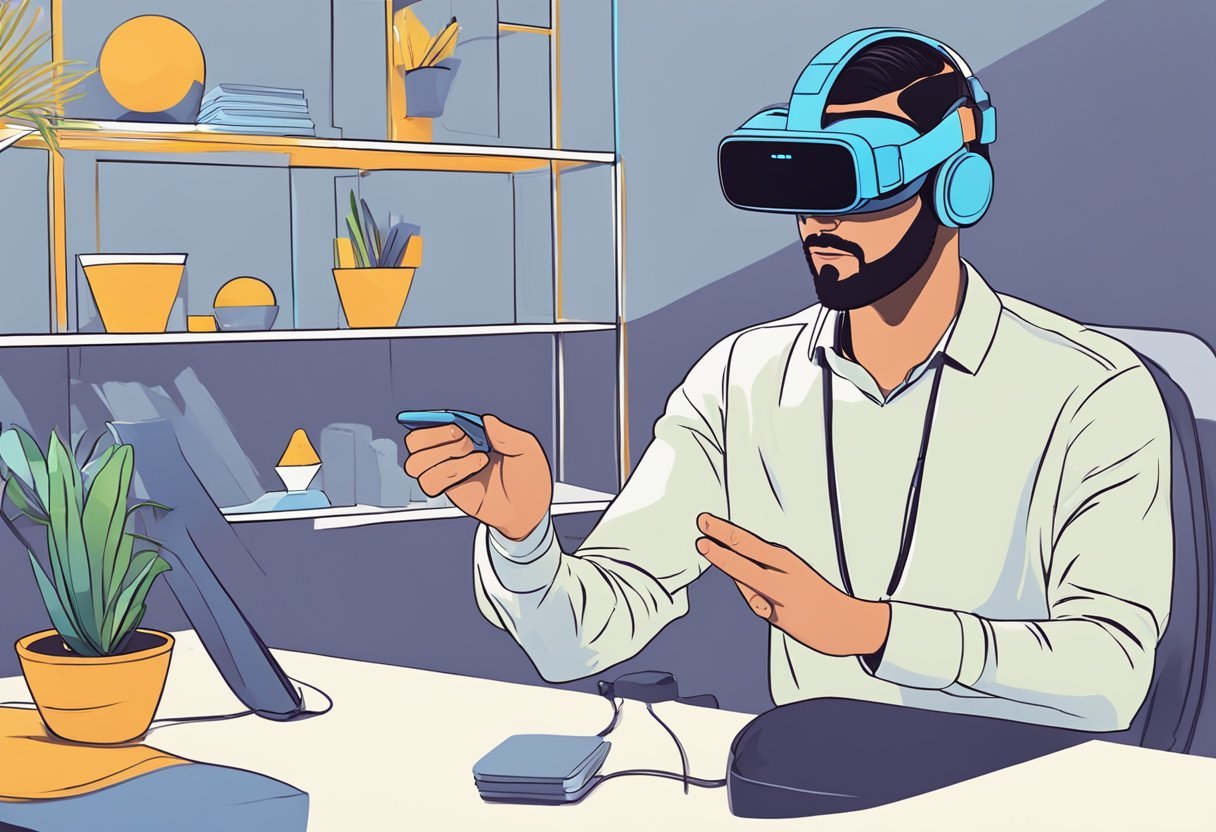AR headsets, also known as augmented reality headsets, are a type of wearable technology that has gained popularity in recent years. AR headsets allow users to view virtual objects overlaid on the real world, creating an immersive experience that can be used for a variety of applications. While the technology is still relatively new, it has already been used in gaming, entertainment, and professional sectors, and is expected to continue to grow in popularity in the coming years.
The evolution of AR headsets has been rapid, with new models and features being released regularly. Understanding AR technology is key to understanding how AR headsets work and how they can be used. AR technology involves the use of sensors, cameras, and other hardware to create a virtual representation of the real world. This virtual representation can be manipulated and augmented in various ways, allowing users to interact with the virtual world in a more natural and intuitive way.
Key Takeaways:
- AR headsets are a type of wearable technology that allow users to view virtual objects overlaid on the real world.
- AR technology involves the use of sensors, cameras, and other hardware to create a virtual representation of the real world.
- AR headsets have a wide range of applications in gaming, entertainment, and professional sectors, and are expected to continue to grow in popularity in the coming years.
Evolution of AR Headsets
The evolution of AR headsets has been a fascinating journey. From the early days of Google Glass to the latest Apple Vision Pro, AR headsets have come a long way in terms of design, functionality, and user experience.
Google Glass was one of the first AR headsets that gained widespread attention. It was a small, lightweight device that could be worn like a pair of glasses. However, it failed to gain traction due to its high price point, limited functionality, and privacy concerns.
The latest Apple Vision Pro, on the other hand, is a more advanced AR headset that offers a range of features such as spatial audio, eye-tracking, and hand gesture recognition. It is also designed to be comfortable to wear for extended periods of time, making it ideal for professional use.
Key Milestones in AR Development
The development of AR technology has gone through several key milestones over the years. One of the earliest milestones was the invention of the first head-mounted display system by Ivan Sutherland in 1968. However, the term ‘augmented reality’ wasn’t coined until 1990 by Boeing researcher Tim Caudell.
Microsoft Hololens was one of the first AR headsets that gained widespread attention in the market. It was launched in 2016 and was designed to be a standalone device that didn’t require connection to a computer or smartphone. Hololens 2, the latest version of the headset, offers improved features such as a wider field of view, better hand tracking, and eye-tracking.
AR headsets have come a long way since their early days. They are now being used in a wide range of industries such as healthcare, education, and entertainment. With the increasing demand for AR technology, it is expected that we will see more advanced and innovative AR headsets in the future.
Technology in AR Glasses

Difference Between AR, VR, and Mixed Reality
Before delving into how AR glasses work, it’s important to understand the difference between AR, VR, and mixed reality. While virtual reality (VR) immerses users in a completely digital environment, augmented reality (AR) overlays digital objects onto the real world. Mixed reality (MR) combines elements of both VR and AR to create a seamless blend of digital and physical reality.
How AR Glasses Work
AR glasses, also known as smart glasses, are wearable devices that use a combination of sensors, cameras, and displays to project virtual objects onto the real world. The glasses track the user’s head movements and position, allowing the virtual objects to appear as if they are part of the user’s environment.
AR glasses work by projecting light onto the user’s eyes through a small display, creating the illusion of virtual objects in the real world. Some AR glasses also include voice recognition technology, allowing users to interact with the virtual objects using voice commands.
One of the main benefits of AR glasses is their ability to enhance productivity and efficiency in various industries. For example, architects and engineers can use AR glasses to visualize and manipulate 3D models of buildings and structures in real-time, while remote assistance and training can be facilitated through AR glasses by providing real-time guidance and instructions.
Design and Features of AR Headsets
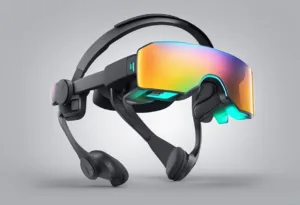
AR headsets are designed to provide users with an immersive experience while also being comfortable to wear for extended periods. The design and features of AR headsets play a significant role in their usability and effectiveness.
Ergonomics and Comfort
AR headsets are designed to be lightweight and comfortable to wear. They are typically made from lightweight materials such as plastic or carbon fiber, which helps to reduce the overall weight of the headset. The ergonomics of AR headsets are also designed to provide a comfortable fit around the head and face. Some headsets feature adjustable straps, which allow users to customize the fit for maximum comfort.
Display and Field of View
The display and field of view are some of the most critical features of AR headsets. The display resolution and field of view determine how immersive the experience is for the user. The display resolution refers to the number of pixels per inch, while the field of view refers to the amount of space that the user can see through the headset.
Some AR headsets feature cameras that track the user’s movements and adjust the display accordingly, providing a seamless experience. The field of view for AR headsets typically ranges from 30 to 110 degrees, with wider fields of view providing a more immersive experience.
The design and features of AR headsets play a significant role in their usability and effectiveness. The ergonomics and comfort of AR headsets are designed to provide a comfortable fit, while the display and field of view determine how immersive the experience is for the user. AR headsets with adjustable straps and wider fields of view tend to be the most comfortable and immersive for users.
AR Headsets in Gaming and Entertainment
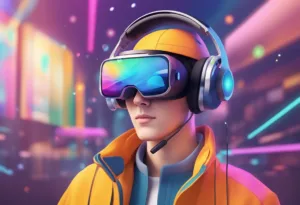
Immersive Gaming Experiences
AR headsets have revolutionized the gaming industry by providing immersive gaming experiences that were once impossible. With AR headsets, gamers can interact with virtual objects and characters in their physical environment, creating a more realistic and engaging experience. The technology allows gamers to move and look around in a virtual world, which enhances the feeling of being inside the game.
One of the most popular AR headsets for gaming is the PlayStation VR2. The device allows gamers to step into the game and experience it from a first-person perspective. The headset is compatible with PlayStation 5, which makes it an attractive option for gamers who own the latest console. The VR2 also has a high resolution and refresh rate, which makes the gaming experience more realistic.
AR in Movies and Live Events
AR headsets are not just limited to the gaming industry. They are also being used in movies and live events to create immersive experiences for the audience. For example, AR headsets can be used to project virtual objects and characters onto a real-world stage, creating a more dynamic and engaging experience.
In the entertainment industry, AR headsets are being used to create interactive experiences for the audience. For example, at live events, performers can use AR headsets to interact with virtual objects and characters on stage, creating a more engaging and memorable experience for the audience.
AR headsets are transforming the way we experience entertainment. They are creating more immersive and engaging experiences for the audience, and the technology is only getting better. As the technology improves, we can expect to see more innovative uses of AR headsets in the entertainment industry.
The Role of AR in Professional Sectors
Augmented Reality (AR) technology has been gaining popularity in various professional sectors, including medical, manufacturing, productivity, and education. AR has the potential to revolutionize the way professionals work, learn, and collaborate.
Medical and Manufacturing Uses
AR technology has been adopted in the medical sector to enhance surgical procedures and medical training. Medical professionals can use AR headsets to project virtual images of a patient’s anatomy onto the real-world view, allowing for more precise surgeries and reducing the risk of complications. AR technology can also be used to simulate medical procedures, allowing medical students to practice and gain experience in a safe and controlled environment.
In the manufacturing sector, AR technology can be used to enhance the efficiency and accuracy of production processes. AR headsets can provide workers with real-time information and guidance, reducing errors and improving productivity. AR technology can also be used to train workers on new equipment and procedures, reducing the time and cost associated with traditional training methods.
Productivity and Education Applications
AR technology can also improve productivity in various professional sectors. AR headsets can provide workers with real-time information and instructions, reducing the need for manual input and improving efficiency. AR technology can also be used to create virtual workspaces, allowing professionals from different locations to collaborate and work together in real-time.
In the education sector, AR technology can enhance the learning experience for students. AR headsets can provide students with immersive and interactive learning experiences, allowing them to visualize complex concepts and gain a deeper understanding of the subject matter. AR technology can also be used to create virtual field trips, allowing students to explore different parts of the world without leaving the classroom.
AR technology has the potential to revolutionize the way professionals work, learn, and collaborate. As the technology continues to advance, we can expect to see more applications of AR in various professional sectors.
Hardware Specifications and Performance
Processor and RAM
The performance of an AR headset is largely dependent on the processor and RAM. In general, a higher-end processor and more RAM will result in smoother and faster performance. The Xreal Air 2 Pro and Xreal Air 2 Ultra are two AR headsets that feature a powerful Qualcomm Snapdragon XR2 processor and 6GB of RAM, which allows for smooth and responsive performance.
The Vision Pro headset by Apple features an impressive 10-core GPU and 16-core NPU, along with 16GB of unified memory. This ensures that the headset can handle even the most demanding AR applications with ease.
Battery Life and Connectivity
Battery life and connectivity are also important factors to consider when choosing an AR headset. The HP Reverb G2 Omnicept Edition boasts a battery life of up to four hours, which is impressive for an AR headset. It features a USB Type-C port for charging and data transfer, which allows for fast and reliable connectivity.
The Valve Index VR Kit features a unique tethering system that connects the headset to a PC, which provides both power and data transfer. This ensures that the headset is always connected and ready to go, without the need for a separate battery.
When choosing an AR headset, it is important to consider the hardware specifications and performance, including the processor and RAM, battery life, and connectivity options. By choosing a headset with powerful hardware and reliable connectivity, users can ensure a smooth and responsive AR experience.
Software and Ecosystem of AR Headsets
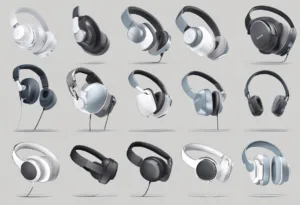
Operating Systems and Compatibility
AR headsets are built with different operating systems that determine the device’s compatibility with other devices. Most AR headsets use Android or iOS operating systems, which are compatible with smartphones. The operating system used also determines the type of apps that can be used on the headset. For example, Apple’s ARKit is a popular platform used for developing AR apps for iOS devices, while Google’s ARCore is used for developing AR apps for Android devices.
AR headsets also require powerful hardware to function effectively. Smartphones are commonly used as the hardware for AR headsets, but standalone AR headsets have their own built-in hardware. Standalone AR headsets are more expensive than smartphone-based AR headsets, but they offer better performance and functionality.
App Ecosystem and Developer Support
The success of AR headsets depends on the availability of apps that can be used on the devices. Developers play a critical role in the development of AR apps, and the support provided by the headset manufacturers is crucial to the success of the app ecosystem.
Apple and Google have invested heavily in the development of AR apps and have provided developers with the necessary tools to create AR apps for their platforms. Developers can use ARKit and ARCore to create AR apps that are compatible with iOS and Android devices, respectively.
In addition to the support provided by the headset manufacturers, there are also third-party platforms that developers can use to create AR apps. Unity and Unreal Engine are popular platforms used for developing AR apps. These platforms provide developers with the necessary tools to create high-quality AR apps that can be used on different AR headsets.
The success of AR headsets depends on the availability of apps that can be used on the devices. The operating system used and the app ecosystem provided by the headset manufacturer are critical factors that determine the success of AR headsets. Developers play a critical role in the development of AR apps, and the support provided by the headset manufacturers and third-party platforms is crucial to the success of the app ecosystem.
Future Trends in AR Headset Development
Advancements in AR Technologies
As AR technology continues to evolve, we can expect to see significant advancements in AR headset development. The use of AR technology is expanding beyond individual products, and we are seeing a shift in how we interact with AR/MR technology. One of the most significant advancements in AR technology is the integration of haptic feedback, which allows users to feel virtual objects as if they were real.
Another area of advancement is the incorporation of AI and machine learning into AR headsets. This will enable AR devices to better understand and respond to their environment, making them more useful in a variety of applications. Advancements in display technology will lead to more immersive and realistic AR experiences.
Predictions for Next-Gen AR Devices
Looking ahead, the next generation of AR devices will likely be smaller, lighter, and more powerful than their predecessors. They will also be more user-friendly, with improved voice and gesture recognition capabilities. We can expect to see AR devices that are integrated into everyday objects, such as glasses, contact lenses, and even clothing.
One of the most significant trends in AR headset development is the move towards wireless and standalone devices. This will allow users to experience AR without being tethered to a computer or mobile device. As AR technology continues to evolve, we can expect to see more sophisticated and advanced AR devices that are capable of delivering truly immersive and interactive experiences.
The future of AR headset development is bright, with many exciting advancements and innovations on the horizon. As AR technology becomes more ubiquitous, we can expect to see it integrated into a wide range of applications and products, from gaming and entertainment to education and healthcare. With the continued evolution of AR technology, the possibilities are truly endless.
Frequently Asked Questions
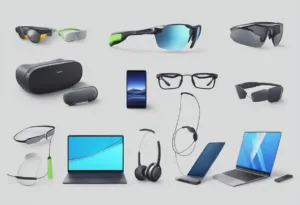
What are the top-rated AR headsets currently on the market?
The top-rated AR headsets currently on the market include Microsoft HoloLens, Magic Leap One, and Nreal Light. Microsoft HoloLens is a self-contained AR headset that provides a mixed reality experience, while Magic Leap One is a lightweight headset that offers a wide field of view. Nreal Light is a consumer-friendly headset that is compatible with smartphones.
How do AR headsets enhance user experience in gaming?
AR headsets enhance user experience in gaming by providing an immersive and interactive environment. Players can see virtual objects overlaid on the real world, and they can interact with these objects using hand gestures or voice commands. This creates a more engaging and realistic gaming experience.
What price range can one expect when shopping for an AR headset?
The price range for AR headsets varies depending on the model and features. Entry-level AR headsets can be found for around $200, while high-end models can cost upwards of $3,000. The average price range for AR headsets is between $500 and $1,500.
What are the key features to look for when purchasing an AR headset?
The key features to look for when purchasing an AR headset include the field of view, resolution, tracking capabilities, battery life, and compatibility with other devices. A wider field of view and higher resolution provide a more immersive experience, while accurate tracking and longer battery life ensure a smoother and more seamless experience. Compatibility with other devices such as smartphones and gaming consoles is also important.
Can AR headsets be purchased through mainstream online retailers?
Yes, AR headsets can be purchased through mainstream online retailers such as Amazon, Best Buy, and Microsoft Store. It is recommended to research and compare different models and prices before making a purchase.
How does the Nreal AR glasses model compare to other AR headsets available?
The Nreal AR glasses model is a lightweight and consumer-friendly AR headset that is compatible with smartphones. It offers a wide field of view and high-resolution display, and it is more affordable than other high-end AR headsets such as Microsoft HoloLens and Magic Leap One. However, it does not offer the same level of tracking capabilities as some of the more expensive models.

